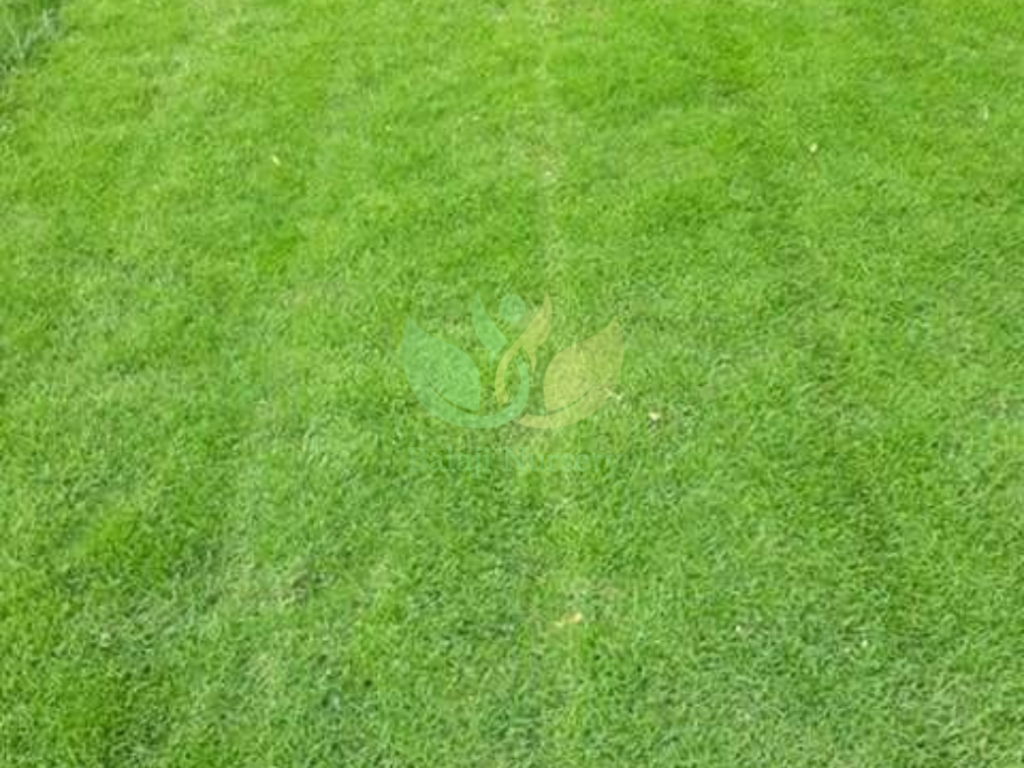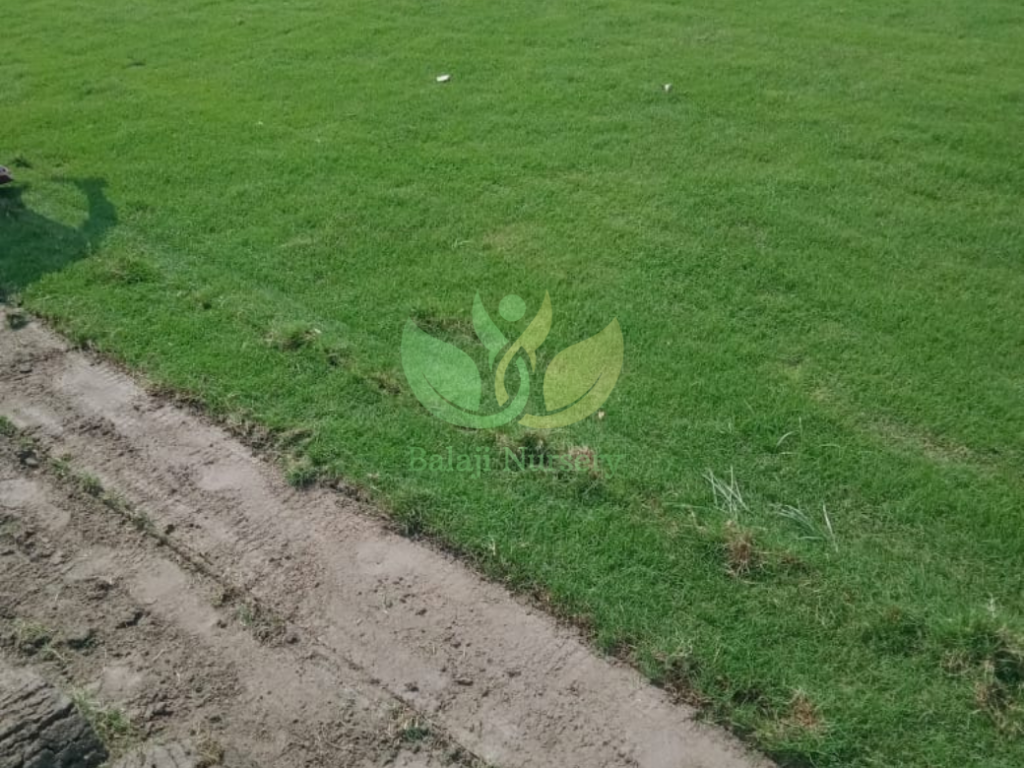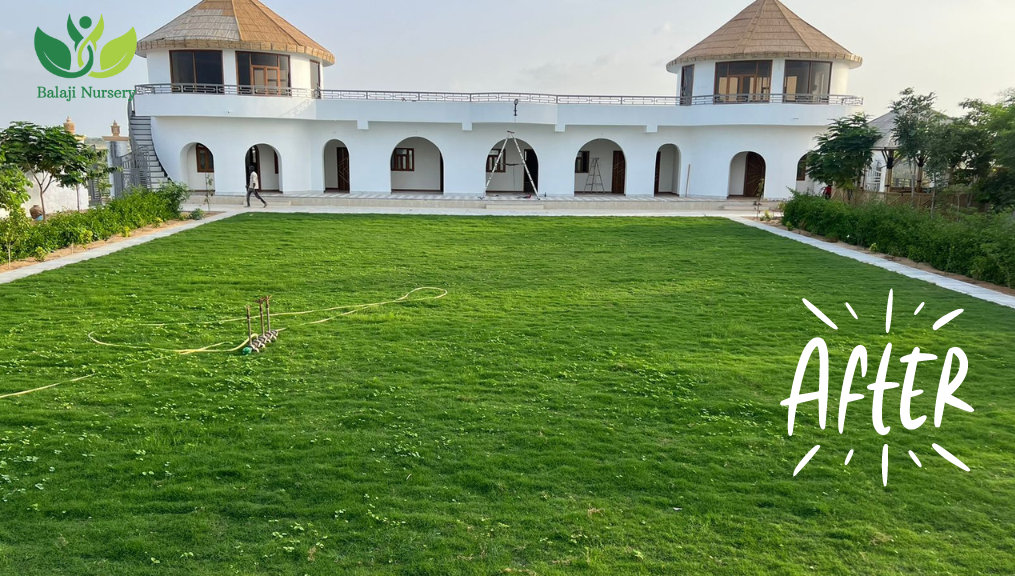7 Best Grass for High Traffic Areas & Lawns
7 Best Grass for High Traffic Areas & Lawns
Is your grass damaged, and are you wondering how to restore a damaged lawn and take other preventive measures? You may want to consider investing in a species of grass that can survive all types of weather and activities.
Keep reading to see which 7 kinds of grass are best for high-traffic areas.
Best High-Traffic Grass Types: Overview and Costs
1. Bermuda Grass

Overview
Grass seeds’ development schedules vary. Bermuda grass is a highly resilient grass variety that comes with strong roots and a rapid growth rate. Its endurance makes it the perfect grass for fields with significant traffic, like golf courses. Bermuda grass also does well in warm-weather areas due to its drought resistance and is a wonderful grass seed for sandy soil. This species of grass ranges in color from blue-green to gray-green to dark green.
Cost
Bermuda grass sod is available for Rs 4 to Rs 10 per square foot.
Watering Requirements
Bermuda grass requires at least 1.5 inches of water each week during the growth season and just 1 inch of water every 3–4 weeks when the grass is brown and dormant. The purpose of watering Bermuda grass is to hydrate the soil down to a depth of 4-6 inches so that deep root development develops.
Growth Stages
During the winter, Bermuda grass is dormant and drab, yet still alive. By early spring, your lawn will begin to wake up, and green shoots will start to sprout up. In late April, with temperatures increasing into the 80s, growth increases, and the Bermuda grass begins to spread and thicken. As summer approaches, temperatures touch the 90s, and a full sun shines, your grass will spike in growth. Bermuda grass will continue to grow throughout the summer and slow throughout the fall when frigid conditions take hold.
Best Variety for High Traffic
Common Bermuda grass, commonly known as seeded Bermuda grass, is the ideal grass for high traffic. Although it has a lower shoot density than other species, typical Bermuda grass has a better nutritional content and grows thicker, which helps it to survive increased foot traffic. Common Bermuda grass is widely used on lawns, public parks, and sports fields.
Other Considerations
Bermuda grass must be fertilized every month during the summer in addition to its watering demands. While this species of grass rarely has insect issues, weeds have the ability to sprout throughout the winter. In colder temperatures, Bermuda grass also becomes more vulnerable to increased traffic.
2. Zoysia Grass

Overview
Zoysia grass is a hardy, warm-weather grass with a thick growth pattern. It grows in many different soil types, although it takes more upkeep than other grass kinds. Zoysia grass is also more susceptible to illness.
Although zoysia grass varies in color and texture, it normally ranges from light to medium green. It grows swiftly in warmer temperatures, giving a lush lawn during the spring and summer seasons.
Cost
Zoysia grass costs Rs 10 to Rs 15 per square foot.
Watering Requirements
Zoysia grass normally requires 1 inch of rainfall or irrigation every week. Infrequent and deep watering fosters the establishment of drought-resistant roots.
Growth Stages
Zoysia grass should be sown in late April when daily temperatures are typically in the 70s and the winter frost has lifted. After 14 to 21 days with ideal growth circumstances, Zoysia seeds germinate and offer magnificent green grass until the cold weather arrives with the first fall frost.
Best Variety for High Traffic
The Meyer Zoysia seed variety is the best Zoysia grass for high traffic and can survive freezing weather. It is endemic to Japan and displays a dark green hue with a broader blade than other zoysias.
Other Considerations
Zoysia grass has a limited drought tolerance and will fall dormant rapidly without sufficient watering in warm weather. Accordingly, Zoysia grass demands plenty of upkeep and has to be fertilized somewhat regularly. These grass seeds are prone to insects, and big patch disease may activate when the soil reaches 65 to 75 degrees.
3. Kentucky Bluegrass

Overview
Kentucky bluegrass is a cool-season species of grass that is particularly popular if you are seeking resilient, gorgeous grass. Although it has a weak root system, this grass develops into a thick turf, protecting it from high foot activity. Kentucky bluegrass creates a gorgeous lawn that is soft, silky, and ranges in hue from blue-green to emerald.
Cost
Kentucky bluegrass costs Rs 12 to Rs 16 per square foot.
Watering Requirements
Kentucky bluegrass seeds require 1 inch of water every week to maintain a healthy green hue and vigorous development. Make sure to fully water your grass when needed, enabling moisture to sink down to the roots. You should also avoid lightly watering this sort of grass since it encourages shorter root systems and weed issues.
Growth Stages
The optimal time to plant Kentucky bluegrass seeds is during the early fall, and then it takes between 14 and 30 days for the seeds to germinate. This kind of grass grows nicely in the cooler months.
Best Variety for High Traffic
Scotts bluegrass seed mix is a cultivar that produces beautiful grass blades, grows well in full light, and tolerates strong traffic.
Other Considerations
Kentucky bluegrass doesn’t have the finest drought tolerance, and it falls dormant during lengthy droughts. Although it can endure high traffic effectively, this kind of grass demands tons of upkeep. In fact, if it obtains minimal nutrients, this sort of grass might experience delayed growth and stripe rust.
Finally, Kentucky bluegrass has a moderate-to-high propensity for disease.
Also Read : Which grass is best for garden in India
4. Perennial Ryegrass
Overview
Perennial ryegrass is the most lasting kind of grass; hence, it is the most favored grass for golf courses in northern regions. This is a variety of grass with robust blades and a strong root structure. As well, it withstands intense foot traffic, is fast-growing, and is drought-resistant. Overall, perennial ryegrass is a fantastic low-maintenance grass species that may be utilized for overseeding during cooler months.
Cost
Perennial ryegrass costs Rs 15 to Rs 18 per square foot.
Watering Requirements
You should guarantee that perennial ryegrass seeds get 1 inch of water every 10 to 14 days. In southern regions, this variety of grass requires roughly 1 inch of water each week.
Growth Stages
Perennial ryegrass can be sown at the beginning of the spring or the end of the summer. This variety of grass takes 5 to 14 days to germinate.
Best Variety for High Traffic
Regenerating perennial ryegrass tolerates considerable foot traffic and has remarkable recuperative qualities. It vastly surpasses typical perennial ryegrass and stays durable during sport and leisure turf usage.
Other Considerations
Using perennial ryegrass to supervise Kentucky bluegrass or other grass seeds helps enhance your lawn and heal bare places. People enjoy perennial ryegrass since it doesn’t take much upkeep and has a very low chance of disease.
5. Turf Grass

Overview
Turf grass covers a multitude of kinds of lawn grass that are supposed to be mowed and trodden on regularly. These combinations of grass seeds are designed to meet problems such as disease susceptibility, a lack of drought tolerance, or the inability to endure heavy traffic.
There are three types of turfgrass mixtures:
Cool-season grasses: this grass variety favors the less harsh summer weather in the North.
Warm-season grasses: this kind thrives in the hot and humid conditions of the South.
Transition zone grasses: this variety of grass does well in mild conditions.
Cost
The typical cost of turf grass is around Rs 5 to Rs 30 per square foot.
Watering Requirements
You should irrigate turf grass every day to keep the soil wet after planting it. As the lawn fills in, you may move to watering twice a week.
Growth Stages
You should anticipate turf grass seeds germinating in about 7 to 21 days under suitable conditions. It may take an extra 3 to 4 weeks before the grass is suitable for mowing. It is recommended to plant your new lawn in the spring in warmer climates. You can wait until the fall to plant your new grass in cooler areas.
Best Variety for High Traffic
There are a lot of different combinations of turfgrass available for purchase. Black Beauty Heavy Traffic Grass Seed is among the best seed combinations for withstanding heavy traffic.
Other Considerations
Although turf grass is a fairly resilient grass, you should be aware that it requires constant mowing, water, raking, weeding, and fertilizer. These rules might become a burden in hot weather and when you’re heading out of town.
6. Tall Fescue Grass

Overview
Tall fescue grass is a wonderful alternative for high-traffic lawns. It has coarse blades with deep roots and is resilient to fluctuating temperatures and water availability. Although tall fescue grass is a cool-season grass variety, it is also exceptionally drought-resistant. Tall fescues vary in hue from mild to dark green.
Cost
Tall fescue grass ranges in price from Rs 4 to Rs 10 per square foot.
Watering Requirements
Tall fescue requires a weekly application of 1 to 1.25 inches of water. The dampness of the soil should seek a depth of 4 to 6 inches. Sandier soils may need more regular irrigation.
Growth Stages
Tall fescue germinates swiftly between 4 and 14 days and establishes quite easily.
Best Variety for High Traffic
Pennington’s The Rebels Tall Fescue Grass Seed Blend is a strong cultivar with deep, dense, and thick roots that can survive in the hardest of situations. It is one of the greatest tall fescue kinds that can resist high traffic.
Other Considerations
Tall fescue has modest care demands and may thrive on soil with minimal fertilizers. It has a minimal possibility of illness and a strong tolerance for insects. Also, you don’t have to worry about thatch since tall fescue stays green throughout the summer.
7. Kikuyu grass
Overview
Kikuyu grass is one of the strongest and most aggressive grass kinds in the world. It is a sun lover and is usually seen on football grounds because of its capacity to grow in poor soil types. Kikuyu grass is somewhat greener in the winter than other grasses but typically does better in warm-weather areas.
Some people don’t appreciate Kikuyu grass since it may readily grow into garden beds and can become hard to remove. On the one hand, its powerful root system permits the maintenance of a healthy lawn. On the other hand, this root structure is the reason why Kikuyu grass grows fast outside its allotted borders.
Cost
Kikuyu grass costs an average of Rs 15 to Rs 25 per square foot.
Watering Requirements
You should water your Kikuyu grass every 7 to 10 days throughout the hot months. In the fall, just a minimum watering is necessary. When watering, you should attempt to keep the soil wet but abstain from overwatering.
Growth Stages
It takes around 10 to 14 days for Kikuyu grass seeds to germinate. You should maintain watering for many weeks following germination. Although growth may be modest at the start, this kind of grass may suddenly speed up and spread across entire yards if not regulated. New lawns should be planted anytime from the spring until the fall.
Best Variety for High Traffic
“Kenda” is the greatest kind of Kikuyu turf and has high drought resistance. It is often utilized in leisure places, including parks, golf courses, sports fields, and racing courses.
Other Considerations
Many people appreciate Kikuyu grass because it does not generate as many seed heads and pollen as other species of grass. These qualities are important for people who suffer from seasonal allergies.
Final Thoughts
When it comes to picking the proper grass seeds, it is of utmost importance to examine their influence on water use and care. Choosing drought-tolerant grass species not only conserves water but also eliminates the need for intensive care. This not only improves the environment but also saves you time and work in keeping a lush, green lawn.7 Best Grass for High Traffic Areas & Lawns
This post has discussed which seven types of grass are suitable for heavy traffic. Not every homeowner has the time to put in the work needed to keep a beautiful green lawn. If you don’t have the time or energy, a professional lawn care business can come to the rescue.
